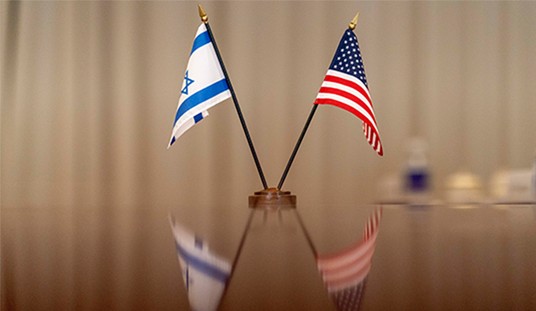Congressman Thaddeus McCotter (R-MI), guest contributing at Ricochet, wonders how culture went off the rails:
A cursory review of American art paints a chiaroscuro chart of our intellectual decimation. In music we’ve tuned out Duke Ellington for R. Kelly. In dance, we’ve stumbled from Gregory Hines to Hines Ward. In television, we’ve turned off Roots for Real House Wives of New Jersey. Mirroring political developments, in motion pictures we’ve replaced Mr. Smith Goes to Washington with Jackass II (apparently the seminal cinematic tour de force Jackass insufficiently slaked our thirst for cerebral stimulation). In art, we’ve turned a blind eye to John Singer Sargent’s World War I inspired Gassed to gape at the comic book derived insipidity of the Obama Joker poster. In literature, we’ve skimmed through F. Scott Fitzgerald’s Tender is the Night to Nikki Sixx’s This is Gonna Hurt. (It did.) Keeping abreast of portentous events, we’ve discarded Chambers’ Witness for Kourtney’s Kardashian Konfidential. And, in poetry – the art of distilling intense feeling through the concise use of language – we’ve replaced Emerson with emoticons.
Pardon me, tweeple? “:-)”?
:-(
Art has always been reflective of the culture that supports it — and needless to say, culture has changed dramatically over the last couple of hundred years. As Tom Wolfe wrote back in 1975, in The Painted Word:
All the major Modern movements except for De Stijl, Dada, Constructivism, and Surrealism began before the First World War, and yet they all seem to come out of the 1920s. Why? Because it was in the 1920s that Modern Art achieved social chic in Paris, London, Berlin, and New York. Smart people talked about it, wrote about it, enthused over it, and borrowed from it, as I say; Modern Art achieved the ultimate social acceptance: interior decorators did knock-offs of it in Belgravia and the sixteenth arrondissement.
Things like knock-off specialists, money, publicity, the smart set, and Le Chic shouldn’t count in the history of art, as we all know—but, thanks to the artists themselves, they do. Art and fashion are a two-backed beast today; the artists can yell at fashion, but they can’t move out ahead. That has come about as follows:
By 1900 the artist’s arena—the place where he seeks honor, glory, ease, Success—had shifted twice. In seventeenth-century Europe the artist was literally, and also psychologically, the house guest of the nobility and the royal court (except in Holland); fine art and court art were one and the same. In the eighteenth century the scene shifted to the salons, in the homes of the wealthy bourgeoisie as well as those of aristocrats, where Culture-minded members of the upper classes held regular meetings with selected artists and writers. The artist was still the Gentleman, not yet the Genius. After the French Revolution, artists began to leave the salons and join cénacles, which were fraternities of like-minded souls huddled at some place like the Café Guerbois rather than a town house; around some romantic figure, an artist rather than a socialite, someone like Victor Hugo, Charles Nodier, Théophile Gautier, or, later, Edouard Manet. What held the cénacles together was that merry battle spirit we have all come to know and love: épatez la bourgeoisie, shock the middle class. With Gautier’s cénacle especially … with Gautier’s own red vests, black scarves, crazy hats, outrageous pronouncements, huge thirsts, and ravenous groin … the modern picture of The Artist began to form: the poor but free spirit, plebeian but aspiring only to be classless, to cut himself forever free from the bonds of the greedy and hypocritical bourgeoisie, to be whatever the fat burghers feared most, to cross the line wherever they drew it, to look at the world in a way they couldn’t see, to be high, live low, stay young forever—in short, to be the bohemian.
By 1900 and the era of Picasso, Braque & Co., the modern game of Success in Art was pretty well set. As a painter or sculptor the artist would do work that baffled or subverted the cozy bourgeois vision of reality. As an individual—well, that was a bit more complex. As a bohemian, the artist had now left the salons of the upper classes—but he had not left their world. For getting away from the bourgeoisie there’s nothing like packing up your paints and easel and heading for Tahiti, or even Brittany, which was Gauguin’s first stop. But who else even got as far as Brittany? Nobody. The rest got no farther than the heights of Montmartre and Montparnasse, which are what?—perhaps two miles from the Champs Elysées. Likewise in the United States: believe me, you can get all the tubes of Winsor & Newton paint you want in Cincinnati, but the artists keep migrating to New York all the same … You can see them six days a week … hot off the Carey airport bus, lined up in front of the real-estate office on Broome Street in their identical blue jeans, gum boots, and quilted Long March jackets … looking, of course, for the inevitable Loft …
But the best of the original modern artists of the early 20th century were those who had traditional training, but who used those techniques in the quest for new forms and styles. Mondrian could pain exceptional portraits and landscapes before going off in search of black lines and primary colors; Mies van der Rohe was highly influenced by German classical architect Karl Friedrich Schinkel (1781 – 1841), and could effortlessly draw buildings in Schinkel’s traditional style, before ultimately narrowing his own palette down to plate glass and I-beams, which keeping a sense of Schinkel’s proportion and grouping in his best buildings.
By the time the Bauhaus arrived on the shores of America in the 1930s and WWII was concluded though, traditional forms of art and architecture were effectively dead, as far as the academy was concerned. In a way, it was a variation on the Whig school of history, which taught that all the divergent paths of history ultimately lead to the liberal freedom of 19th century England, (or the Marxist school of history, for the flip-side). If all roads lead to modernism, minimalism and “starting from zero,” why bother to learn the techniques of the past?
In pop music, the Beatles absorbed large influences of traditional popular musicians such as Cole Porter and George Gershwin, and via producer George Martin, classical music, in addition to Little Richard, Chuck Berry, and Buddy Holly. But today, so dominant was the Beatles’ influence on pop culture, traditional forms of music have been bulldozed over by rock and rap. The classical orchestra is now reduced to a key on a synthesizer; as McCotter notes above, language has effectively been condensed down to emoticons. Orwell’s outer party worker drones in the Ministry of Truth boiling down the Newspeak Dictionary into successively smaller new editions had no idea how tiny the final version would ultimately become.
Modern art and rock music were both countercultural forms; but today, there’s no dominant popular culture for them to push against, and hence there’s no reason for them not to recall the techniques, or the culture of the past.
By the way, apropos of nothing, there’s a direct line between Wolfe’s artists making the Apache Dance and jettisoning their individuality (and likely a good chunk of their technical skill) for the extremely long odds of stardom in the New York Art World to this.










Join the conversation as a VIP Member